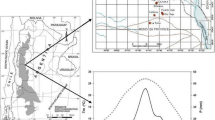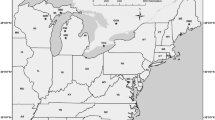Abstract
This paper presents the results of studies aimed at identifying statistical relationships between the landscape structure and variability in Siberian stone pine (Pinus sibirica) increments in the permafrost–hillocky northern-taiga landscapes of Western Siberia (Nadym River basin). Dendrochronologies of Siberian stone pine growing on frost mounds of different types are compiled. Principal component analysis is applied to obtain independent variables that describe the site and landscape structure of the territory. Cores from 512 trees growing on 23 frost mounds are analyzed. The following methods are used: crossdating, dendrochronological standardization, and the elimination of monotonic trends for each tree. Results of the classification of Sentinel satellite images were used to calculate the proportions of lakes, forests, sparse forests, floating bogs, and flat–hillocky peat bogs, with the radius of the vicinity of a frost mound of 100‒2000 m. Correlation, dispersion, and regression analyses are used in the analysis of the dependence of the median increment on the characteristic of the mound site and landscape neighborhoods. It has been established that on high mounds the variability in increments is higher on tops than on slopes, whereas the situation is often reversed on low mounds. It is also found that the tops and slopes of the frost mounds respond differently to climatic fluctuations depending on the landscape structure and the height of the mound: the close proximity of lakes reduces the variability of phytoproductive functioning on the summit surfaces. It is revealed that the sensitivity of Siberian stone pine growth to temperature fluctuations increases with an increase in the diversity of the facies structure caused by the development of thermokarst subsidence and cryogenic cracks.

Similar content being viewed by others
REFERENCES
Turner, M.G. and Gardner, R.H., Landscape Ecology in Theory and Practice. Pattern and Process, New York: Springer, 2015.
Hall, O., Hay, G.J., Bouchard, A., and Marceau, D.J., Detecting dominant landscape objects through multiple scales: An integration of object-specific methods and watershed segmentation, Landscape Ecol., 2004, vol. 19, no. 1, pp. 59–76.
Konovalova, T.I., Cartographic modeling of geosystems variability, in Modelirovanie geograficheskikh system (Modeling of Geographic Systems), Irkutsk: Inst. Geogr. Sib. Otdel. Ross. Akad. Nauk, 2004, pp. 24–28.
Kolomyts, E.G. and Sharaya, L.S., Influence of global warming on the landscape structure of the North Caucasus, Izv. Ross. Akad. Nauk. Ser. Geogr., 2012, no. 4, pp. 45–61.
Shugart, H.H., Michaels, P.J., Smith, T.M., Weinstein, D.A., and Rastetter, E.B., Simulation models of forest succession, in SCOPE 35. Scales and Global Change: Spatial and Temporal Variability in Biospheric and Geospheric Processes, New York: John Wiley and Sons, 1988.
Phillips, J.D., Global and local factors in earth surface systems, Ecol. Modelling, 2002, vol. 149, no. 3, pp. 257–272.
Rupp, T.S., Starfield, A.M., and Chapin, F.S., III A frame-based spatially explicit model of subarctic vegetation response to climatic change: Comparison with a point model, Landscape Ecol., 2000, vol. 15, no 4, pp. 383–400.
Vaganov, E.A., Shiyatov, S.G., Khantemirov, R.M., and Naurzbaev, M.M., Variability of summer air temperature at high latitudes of the Northern Hemisphere over the past 1.5 thousand years: A comparative analysis of data from tree rings and ice cores, Dokl. Akad. Nauk, 1998, vol. 358, no. 5, pp. 681–684.
Kompleksnyi monitoring severotaezhnykh geosistem Zapadnoi Sibiri (Integrated Monitoring of the Northern Taiga Geosystems of Western Siberia) Mel’nikova, V.P, Ed., Novosibirsk: Akad. Izd. “Geo”, 2012.
Bochkarev, Yu.N., Long-term dynamics of heaving mounds in the north of Western Siberia according to dendrochronology data, Vopr. Geogr., 2014, vol. 138, pp. 251–270.
Ponomareva, O.E., Gravis, A.G., Berdnikov, and N.M., Modern dynamics of frost mounds and flat-hillocky peat bogs in the northern taiga of Western Siberia (on the example of the Nadym station), Kriosfera Zemli, 2012, vol. 16, no. 4, pp. 21–30.
Vasil’chuk, Yu.K., Vasil’chuk, A.K., and Budantseva, N.A., Migratory frost mounds in the north of Western Siberia: the southern and northern limits of the area and modern dynamics, Inzhener. Geol., 2012, no. 6, pp. 18–32.
Moskalenko, N.G., Vegetation changes in the north of Western Siberia under changing climate and technogenic changes, Izv. Ross. Geogr. O-va, 2012, vol. 144, no. 1, pp. 63–72.
Bochkarev, Yu.N. and D’yakonov, K.N., Dendrochronological indication of the functioning of landscapes on the northern and upper boundaries of the forest, Vestn. Mosk. Univ. Ser. 5. Geogr., 2009, no. 2, pp. 37-50.
Nikolaev, A.N. and Skachkov, Yu.B., Influence of snow cover and temperature regime of permafrost soils on the radial growth of trees in Central Yakutia, Zhurn. Sib. Feder. Univ. Biol., 2012, no. 5, pp. 43–51.
Vasil’chuk, Yu.K. Vasil’chuk, A.K., Budantseva, N.A., and Chizhova Yu.N., Vypuklye bugry pucheniya mnogoletnemerzlykh torfyanykh massivov (Convex Frost Mounds of Permafrost Peat Massifs), Moscow: Izd. Mosk. Univ., 2008.
Seppälä, M., Synthesis of studies of palsa formation underlining the importance of local environmental and physical characteristics, Quaternary Res., 2011., vol. 75, pp. 366–370.
Mel’nikov, E.S., Tagunova, L.N., Lazareva, N.A., and Moskalenko, N.G., Landshafty kriolitozony Zapadno-Sibirskoi gazonosnoi provintsii (Landscapes of the Permafrost Zone of the West Siberian Gas-Bearing Province), Novosibirsk: Nauka, 1983.
Berdnikov, N.M., Frost mounds in various landscapes of the Nadym River basin, Kriosfera Zemli, 2012, vol. 16, no. 3, pp. 81–86.
Cook, E.R. and Holmes, R., Guide for computer program ARSTAN, in Tree-Ring Chronologies of Western North America: California, Eastern Oregon and Northern Great Basin, Tucson: Univ. of Arizona, 1986.
Kapralova, V.N., Patterns of the development of thermokarst processes within lacustrine-thermokarst plains (based on the approaches of mathematical landscape morphology), Extended Abstract of Cand. Sci. (Geol.-Min.) Dissertation, Inst. Geoekol. Ross. Akad. Nauk, Moscow, 2014.
Ponomareva, O.E., Gravis, A.G., Blyakharchuk, T.A., Bochkarev, Yu.N., Ustinova, E.V., Berdnikov, N.M., and Moskalenko, N.G., Response of the island cryolithozone of the northern taiga of Western Siberia to climate change, Materialy V konf. geokriologov Rossii (Materials of the V Conf. of Geocryologists of Russia) (Moscow, 2016), Moscow: Universitetskaya Kniga, 2016, vol. 2, pt. 6, pp. 107–114.
Funding
This work was financially supported by the Russian Foundation for Basic Research (no. 19-05-00786).
Author information
Authors and Affiliations
Corresponding authors
Ethics declarations
The authors declare that they have no conflicts of interest.
Additional information
Translated by S. Avodkova
Rights and permissions
About this article
Cite this article
Volovinskii, I.V., Khoroshev, A.V. & Bochkarev, Y.N. Landscape Structure as the Regulator of the Siberian Stone Pine Growth Dynamics in the Northern Taiga of Western Siberia. Geogr. Nat. Resour. 43, 156–162 (2022). https://doi.org/10.1134/S1875372822020111
Received:
Revised:
Accepted:
Published:
Issue Date:
DOI: https://doi.org/10.1134/S1875372822020111




